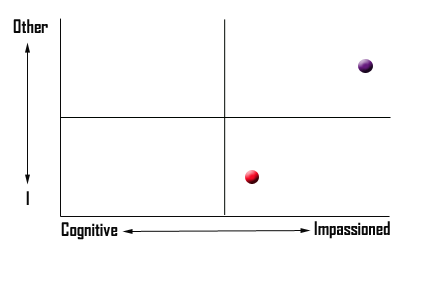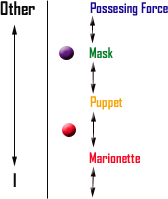So my Great Aunt Gertrude keeps asking me to get on with writing more about that body of post-immersionist theory (thanks Mick, great way to put it!) I’d been working on last year, and it just so happens I have a couple more things I’ve been itching to talk about: The first of a pair is context. The second will come in a later post.
As you might have suspected, I’m really big on context – all my theory’s heavily invested in the idea that play success is wholly dependant on the contextual positioning of the player in relation to everything else: other players at the table, social contract, system, preferred payoffs, goals, modes of play, yadda, yadda, yadda.
But, for the purposes of this post, I’m going to use the word context contextually: what I’m specifically looking at here is the player’s requirement for context. Also, while I absolutely think this discussion has application with some of the other sockets, mostly I’ll be talking about character socket play, because, well, that’s what I like & know best, and so focus on. So in a nutshell, what I’m looking at is how much or how little contextual establishment a player requires for her character in a game, and how I think that might relate to her payoff, goals and modes of play.
So what is contextual establishment? Well it has to do with how a character relates to herself, the world, the story, the other characters. As a person, you have a context in every moment of every day. That context is critical to your understanding of the world and to your ability to interact in it. It is built by all of your past experiences, by an inventory of your present situation, by the expectations which you invest in the world, and your ability to forecast future outcomes.
Picture this: You and your friend John are walking through the mall. You’re looking to buy a new leather jacket which is going to cost 500 dollars and you’re planning on paying cash. You’re counting out the money on the way to make sure that you have enough.
Now picture this: You and your friend John are walking through the mall. You’re looking to buy a new leather jacket which is going to cost 500 dollars and you’re planning on paying cash. You know that John has compulsive habit of punching people in the head when he sees large sums of money and taking it because he’s done it to you a half a dozen times. Are you still counting out the money on the way? (Why, you’re probably asking, am I even with John at the mall?)
Now picture this: You and your friend John are walking through Compton. You’re on the way to the store to buy a new leather jacket which is going to cost 500 dollars. Are you carrying 500 dollars in cash? If you are, are you counting it there in the middle of the street? Are you still with John, given that he’s a reckless head-punching bastard?
So yeah, as a person, context affects how we feel about things when they happen and how we decide what to do in response to them. Most of the time we don’t notice our internal relationship with context. We have long-tuned instinctual processes built to deal with it like the one that makes you flinch in fear when that head-punching bastard moves his arm quickly but doesn’t when your cat Buster darts across your lap.
When context changes radically or inexplicably, the instinctual processes can totally break down. And as anyone who’s ever traveled extensively can tell you, being deprived of context (cultural context, for this example) over a long period of time can be disorienting or even frightening. Learning to intentionally work through differences in context (rather than instinctually coasting through sameness in context) causes a lot of cognitive dissonance.
When I lived in Brazil or India everything I did, no matter how simple, took energy and focus because I had to work to understand the cultural context of everyday life and try harder than usual to act within that model. The propensity for failure to understand the context and then act inappropriately also became greater, which caused a heightened sense of latent (and sometimes acute!) anxiety than I would otherwise feel.
So in roleplaying context is important too. All players need at least a little context to get traction in play, and some players need a lot more than that. At a broad and basic level, context is established through setting, system, genre, and past play (among others). Telling you the game we will play takes place in the real world, gives you different building blocks to build a contextual model than telling you it takes place in Narnia, Glorantha, or aboard the Millennium Falcon. Telling you that the game will be a pulp, will affect your mental model differently than if I’d said western, noir, or space opera. This is really why RPG’s loves them some genre and why games in general are prone to setting books, splatbooks, archetype lists etc. etc. They are all ways to shortcut communal context around the table and get people in position to play together.
You can cut context a thousand ways but where I want to get to in this discussion is that beyond the communal context at the table which everyone needs and which makes the game possible, some players require specifically higher degrees of context to achieve their goals in play, interact with their character in mode or get at their payoff. Some examples:
- Higher context players might require historical context in character (like a background), to provide a contextual sense of where the character has come from and who the character is as a person whereas a lower context player may prefer the character to be a blank slate that’s fully open to interpretation.
- Higher context players might require in character social freeplay to get a sense of the contextual relationship between their character and other personas (PC or NPC) in the fiction while lower context players might find it just as satisfying to invent those relationships on the fly.
- Higher context players may need contextualization before conflict to position themselves to be able to experience the interaction whereas lower context players might more fully enjoy the experience if they’re given the thrill of in medias res scene framing.
- Higher conflict players may prefer moment-to-moment or event-to event play while lower context players might find time lapsing or sudden time jumping a happier pace.
Of course, I shouldn’t have to say this because if you’re reading my blog you should already know that it’s implied, but: there’s no objective right or wrong, better or worse in this equation. Whether high or low, the threshold of context required by a player is relational to their enjoyment of play and the only place better/worse comes in is in how well the player’s payoff was realized.
Calibrating context correctly is an important process to enjoyment in game. Like me in India, the farther away you are from the context you’re expecting the less comfortable the game will be and the more detracting from fun. I suspect I understand how this trends with other elements of the emotional agenda, but I’m not ready to point at it until I’ve established the piece it’s (fraternally) twinned with.
Next up: Relief.

